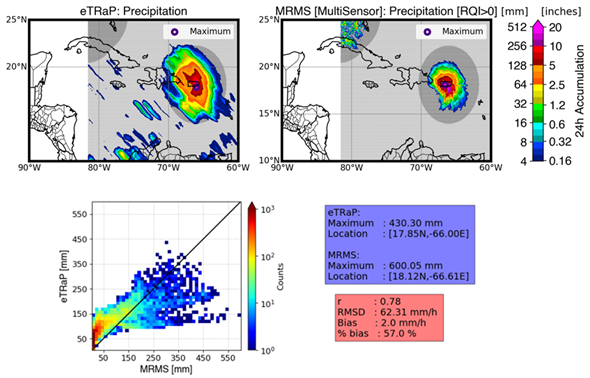
Tropical Storm Fiona struck Puerto Rico on September 17-18, 2022 causing catastrophic floods and leaving most of the island with a major power outage. Fiona is the first Atlantic storm this season to cause a major disaster. NPreciSe (NOAA Satellite Precipitation Validation System) led by the CISESS science team (Huan Meng, Malar Arulraj, Veljko Petkovic, and Ralph Ferraro), evaluated the performance of the Ensemble Tropical Rainfall Potential (eTRaP) forecasts during this event, using a recently added Multi-Radar/Multi-Sensor (MRMS) observation product over Caribbean Islands.
The eTRaP forecasts 24-hour accumulation of precipitation from tropical storms and hurricanes with a lead time of 6- to 24-hour period using initial conditions from satellite-based microwave sensors. NPreciSe found eTRaP forecast during Fiona to be highly accurate in predicting the storm’s structure and maxima location (Figure 1 – Top Panel). Despite the accumulation being underestimated by up to 200 mm per day (typical for island TC events), the overall correlation between the predicted and observed rainfall is high (0.78; Fig.1 bottom panels) confirming the high value of the eTRaP product to the users and forecaster communities.
Meng is a physical scientist with NOAA/NESDIS Satellite Climate Studies Branch, and a visiting associate scientist at ESSIC. She received a MS in Physical Oceanography from Florida State University in 1993, and a PhD in Hydrology from Colorado State University in 2004. She has been working in the field of satellite remote sensing since 1999. Her current research topics include the use of satellite passive microwave measurements for both the retrieval of snowfall rates, and the development of Climate Data Record (CDR).
Arulraj is a postdoctoral associate at CISESS/ESSIC. Her research focuses on precipitation remote sensing, especially understanding precipitation microphysics and improving satellite-based retrievals using machine learning and statistical methods.
Petković joined ESSIC in 2017 after graduating at the Department of Atmospheric Science at Colorado State University. His research interests are in hydrology, atmospheric radiative transfer, and microwave remote sensing, with focus on satellite retrievals, cloud microphysical processes and their interactions with a large-scale environment.
Ferraro is the Associate Director of ESSIC and former Chief of the NOAA/NESDIS Satellite Climate Studies Branch. Ferraro joined NOAA in 1991 as a Physical Scientist, and became one of the original group of five scientists in SCSB in 2003. During his career, Ferraro has been affiliated with several science teams. Ferraro’s current research focuses on the use of environmental satellite remote sensing for both weather and climate studies with an emphasis on precipitation and other hydrological cycle products.
To access the eTRaP product, click here: Ensemble Tropical Rainfall Potential (eTRaP).






